Abstract
Population expansion and the development of technology have led to an increase in construction activities. In many cases, foundation grounds do not have a high enough bearing capacity and are not capable of ensuring the safe exploitation of the construction. A soil with poor mechanical characteristics must be improved using various methods, such as adding hydraulic binders (lime and cement), natural fibres, or more recently, plastic waste materials. This work aims to study the behaviour of plastic waste materials made from polyethylene terephthalate (PET) in soil improvement. Thus, the mechanical characteristics of a clay improved with shredded PET were studied. PET was added in relation to the dry mass of the clay, in percentages of 2%, 4% and 6%. The studied clay was collected from a construction site around Cluj-Napoca, Romania, from a depth of 1 ÷ 10 m. PET was provided by a local plastic waste repository. It comes from recycled water, beer and soda bottles and was cleaned using specific methods for cleaning and recycling plastic waste. PET was shredded into irregular shapes with sizes ranging from 3 mm to 12 mm and was randomly distributed in the test specimens. Compression and direct shear tests were carried out to study the compressibility and shear parameters of the improved soil (internal friction angle and cohesion). The experimental results showed an improvement in the mechanical characteristics of the clay even at a low PET addition of 2% and 4%. This method can contribute to solving two current problems of the modern world: reducing pollution by recycling plastic waste materials and using them to improve the mechanical characteristics of soil.
1. Introduction
Over 300 million tons of plastic waste materials are generated annually, with a significant amount ending up in the environment, where they persist for decades [1]. Each year, at least 8 tons of plastic waste materials make their way into the ocean, which is equivalent to a garbage truck dumped into the ocean every minute. If no measures are taken, it is estimated that by the year 2030, the quantity will increase to two trucks per minute, and by 2050, it will reach four trucks per minute [2,3]. Finding solutions for the elimination or environmentally friendly reuse of these waste materials is necessary [4].
Recent studies have shown a new approach to reuse plastic waste materials in geotechnical engineering in soil improvement and stabilization [5,6,7,8,9,10]. Soil improvement and soil stabilization are terms used to describe any technique, be it physical, chemical, biological, or a combination of these, that alters the properties of natural soil to meet specific requirements for geotechnical engineering.
If the available soil is inadequate to support the loads of engineering structures, traditional methods of improvement and stabilization of soil using hydraulic binders are already known [11,12]. However, this method often proves to be costly due to the high price of additives.
The concept of soil reinforcement with fibres was introduced by Vidal in 1969, who observed an increase in the shear parameters of reinforced samples [13]. Since then, research into improving soils with fibres has advanced, and nowadays both natural and waste fibres are used in the process. Research has been performed on improving soils with fibres from bamboo [14,15], jute [16,17], coir [18,19], palm [20,21], sugar cane [22], waste rubber [23,24], and waste plastics [25,26,27]. In most cases, the results showed an increase in the geotechnical parameters considered in the studies such as an increase in the internal friction angle and cohesion, an increase in the shear strength of the soil, improved compressibility, and improved behaviour of the studied soil to moisture variations.
The use of plastic waste materials in soil improvement can serve as a means of recycling and reusing these waste materials, providing an efficient soil improvement method at reduced costs. By collaborating with local plastic waste repositories, it is possible to acquire the raw material for improving and stabilizing soils. Soil improvement with plastic waste materials might raise ecological discussion, but further research must be conducted to determine the viability of this solution.
The civil engineering field includes various applications of plastic waste materials, such as using them for soil stabilization in base and subbase layers of pavements, reinforcing earthen embankments, and mitigating soil settlement in foundations. Waste plastic materials can also serve as a cost-effective substitute for other expensive admixtures like cement and lime in soil improvement processes.
The purpose of this paper is to study the geotechnical parameters of a clayey soil improved with shredded polyethylene terephthalate (PET) waste. This paper will highlight the beneficial effect of PET waste on clayey soil by analysing the variation in the internal friction angle, cohesion, shear strength, and compressibility, as the percentage of added PET in the test samples increases. The use of PET waste from water, soft drinks and beer bottles in soil improvement offers a solution to two major current problems: reducing pollution through recycling and reusing plastic waste materials (PET), and improving the mechanical properties of soils for adequate load-bearing capacity during engineering constructions.
Polyethylene terephthalate (C10H8O4)n, commonly referred to as PET, is a polymer synthesized from petroleum hydrocarbons by combining ethylene glycol and terephthalate acid. With its notable characteristics of exceptional wear resistance, a low friction coefficient, and a high flexural modulus, PET is recognized as a beneficial additive for soil stabilization, improving the geotechnical properties of the soil [28].
2. Literature Review
In the literature, different types of soils improved with different waste plastic materials, in the form of fibres, granules, strips, have been studied. The main objective of these studies was to improve the geotechnical parameters of the soils.
Poweth et al. [29] studied the behaviour of a clay of intermediate compressibility from Kerala district, India, improved with different percentages of plastic granules. The plastic granules were added in a proportion of 0.25%, 0.5% and 0.75% by the weight of dry clay. The investigation determined that the improvement method proved to be a proficient technique for improving the geotechnical characteristics of the clay. An improvement in the compressibility of the clay was found, as well as an increase in the shear strength. Optimum results were obtained for 0.25% plastic granule addition by the weight of dry clay.
A study conducted by Singh and Sonthwal [30] showed the effect that PET waste in the form of strips has had in reinforcing a clay of low compressibility used in the subgrade of a pavement. After a series of California bearing ratio (CBR) and Proctor compaction tests an improvement in the dry density and CBR values of the reinforced samples was found. Optimum results were found for the samples formed from clay and 6% PET strips (25 mm × 5 mm) added by the dry weight of the soil. It was noted that the optimum percentage of PET waste used for clay reinforcement caused a reduction in the thickness of pavement, which led to a reduction in the cost of the project.
Peddaiah et al. [31] conducted a standard Proctor test, Direct Shear Test and CBR tests on samples made from a silty sand reinforced with PET wastes strips. Tests results indicated a substantial increase in the maximum dry unit weight, shear strength parameters, and CBR value when PET waste reinforcement is added to the silty sand. The level of improvement in silty sand’s geotechnical proprieties varies depending on factors such as the soil type, plastic material content, and strip size. For these tests, the optimum results were obtained when using a PET waste content of 0.4% along with a strip size of (15 mm × 15 mm).
Using polyethylene plastic waste bags in soil improvement and stabilization has been investigated in various geotechnical infrastructure applications, such as slope stabilization, embankments, and road bases. Tests have demonstrated that the incorporation of plastic waste materials into soil improves the bearing capacity and shear strength of weak soils, diminishes soil settlement and increases resistance against liquefaction while improving durability [32,33,34,35].
Zukri et al. [36] studied the proprieties of a soft clay from Pahang, Malaysia, improved with different percentages (0%, 5%, 10% and 20%) of polyethylene terephthalate and polypropylene (PP) in random distributions. A total of 22 samples were prepared and subjected to unconfined compression tests (UCT). Test results showed that the unconfined compressive strength (UCS) increased progressively as the percentage of PET fibre reinforcement in the soil increased, until it reached its peak at an optimal content of 10% fibre reinforcement. In the case of polypropylene fibres, the soil reached its maximum strength when it contained a 20% fibre content.
The encouraging results found in the literature illustrate that the addition of plastic waste materials in soil improvement has a beneficial effect on the geotechnical characteristics of soils. The research carried out on this topic shows that the field studied is of great interest all over the world. This field offers solutions to two current problems: reducing plastic pollution by reusing materials considered to be waste and increasing the mechanical properties of soils with poor characteristics to support the loads from engineering structures.
3. Materials and Methods
The flow chart of the procedure followed to obtain the samples for tests can be analysed in Figure 1.

Figure 1.
Flow chart of the procedure followed to obtain the samples.
The soil used in this study is a silty clay with medium swelling and shrinkage activity (classification according to the Romanian Norm NP 126/2010 [37]) (Figure 2a). It was collected from a site in the Cluj-Napoca area, Romania, from a depth of 1–10 m. The physical proprieties and granulometric composition of this clay are shown in Table 1 and Table 2.
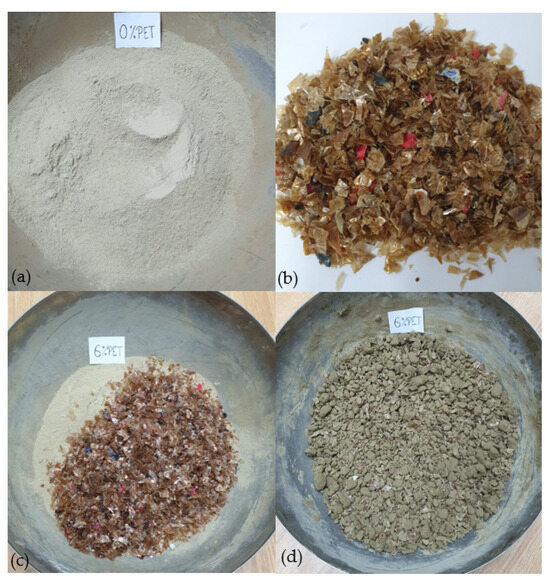
Figure 2.
Used materials: (a) clay; (b) shredded PET; (c) clay + 6% PET; and (d) clay + OWC + 6% PET.

Table 1.
Physical properties of used clay.

Table 2.
Granulometric composition of used clay.
The polyethylene terephthalate used in the clay–PET admixtures was provided by a local plastic waste recycling repository. PET came from recycled water, beer and soda bottles and was cleaned using specific methods for cleaning and recycling plastic waste materials: it was washed and the impurities were removed, it was shredded, and it was washed again and dried. The PET used in this study had irregular shapes, with sizes ranging from 3 mm to 12 mm (Figure 2b). The test samples were created in the laboratory by manually mixing clay with different percentages of PET (2%, 4%, 6%), randomly distributed.
The amount of PET added was related to the dry mass of the clay. For each test, 4 types of samples were produced (0%, 2%, 4%, 6%), each type containing 3 samples. To produce 3 samples of one type, 2000 gr. of clay sieved through a 2 mm sieve was manually mixed with one percent of PET (i.e., for a percentage of 6% PET, a quantity of 120 gr. of shredded PET was added to the 2000 gr. of clay) (Figure 2c). The admixture was then mixed with the optimum water content (OWC) of 18% (Figure 2d). The optimum water content is the water content at which, because of compaction in the Proctor apparatus, a maximum measurable density is obtained. After compaction in the Proctor apparatus (Fröwag, model 2151), the three samples were collected.
A total of 12 square samples (6 cm × 6 cm × 2 cm) were collected from the Proctor apparatus for direct shear tests and 12 round samples (6 cm × 2 cm) from oedometric compression tests (Figure 3a–c). The composition of each type of samples, their coding and form is given in Table 3.
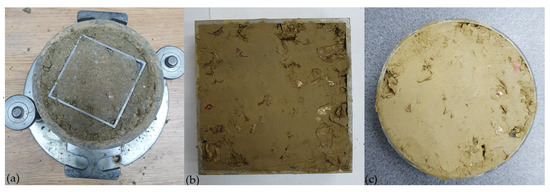
Figure 3.
Samples: (a) extraction of clay–PET samples from Proctor Apparatus; (b) square clay–PET sample; and (c) round clay–PET sample.

Table 3.
Samples codes and composition.
All tests were performed according to Romanian standards, valid at the beginning of the experimental programme. The optimum water content was determined as per standard STAS 1913/13-83 [38]. Direct shear tests were performed according to STAS 8942/2-82 [39] and compression tests were performed according to STAS 8942/1-89 [40]. The equivalent of these standards can be found in SR EN ISO 17892—Geotechnical investigation and testing [41].
Direct shear tests were performed on samples immersed in water under consolidated–drained conditions (CD). The consolidated–drained shear test is performed when the soil is loaded at a slow rate and there are natural conditions for water drainage from the soil pores. The shear velocity used was 0.02 mm/min.
The parameters obtained from the direct shear test under CD conditions are the effective maximum shear strength parameters of the soil (angle of internal friction—Φ′; cohesion—c′). The direct shear test requires a minimum of three samples of same type to be sheared in an imposed plane, each sample subjected to a different vertical load (σ). In this study, the vertical stress (σ) values were 100 kPa, 200 kPa, and 300 kPa. By processing the results within a coordinate system, three points will be identified, which are used to draw the soil characteristic line. For the studied clay, the equation describing the soil characteristic line is .
The execution of the direct shear test consists of applying vertical stress, flooding the sample, consolidating the sample and shearing the sample. The sample is sheared after the consolidation is completed, under the applied vertical stress, by starting the shearing device.
Compressibility is the property of soils to deform under external compressive stresses. Determining the compressibility of soils in the laboratory consists of monitoring the vertical deformation (ε) of soil samples under vertical loads (σ), which are applied in stages.
The compressibility of samples was determined in the laboratory with Wykeham Farrance equipment, model 26-WF0312. Deformation measurements under constant loads were carried out on cylindrical specimens with no lateral deformation and with drainage on the lower and upper faces.
In the oedometric compression test, the sample is placed in the apparatus and the first stage of vertical axial stress (σ) is applied. The sample deformation is recorded at certain time intervals. After the deformation is stabilized under the respective stress stage, the next stage of axial stress is then applied. The sample deformation is recorded at the same time intervals. After application of the last vertical axial-stress stage and stabilization of the deformation, the sample is unloaded to the initial stage, which is maintained until stabilization, and the final deformation is recorded.
Oedometric Compression tests were carried out on saturated and immersed samples, and the vertical axial stresses applied were from 20 kPa to 1000 kPa. The results are presented in the next chapter for the four types of admixtures: Cl, Cl2PET, Cl4PET and Cl6PET.
4. Results
4.1. Direct Shearing Tests
The shear strength has two characteristic values: peak and residual. Corresponding to these parameters, there will be two distinct soil-characteristic lines, with which the shear parameters ϕ′ and c′ as the peak values and ϕres and cres as the residual values can be determined.
Analysing the direct shear tests results (Table 4, Figure 4 and Figure 5) realized with Wykeham Farrance equipment, model 27-WF0215/B, it can be observed that the shear strength increased at an addition of 2% and 4% PET, both for the peak and residual values.

Table 4.
The shear strength (τf) for the four types of admixtures.
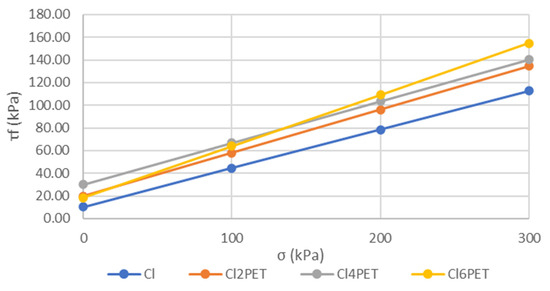
Figure 4.
Soil characteristic lines for the four types of admixtures—peak parameters.
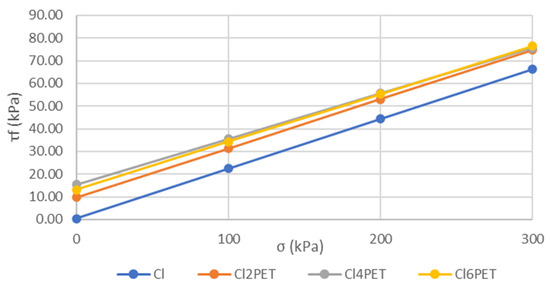
Figure 5.
Soil characteristic lines for the four types of admixtures—residual parameters.
In the case of peak parameters, for a vertical stress of 100 kPa, the shear strength increased progressively from an initial value of 44.47 kPa for Cl to 58.03 kPa for Cl2PET, then to 66.76 for Cl4PET, decreasing to a value of 63.89 kPa for the Cl6PET admixture. The same increasing upward trend can be observed for vertical stresses of 200 kPa and 300 kPa.
An improvement in the clay shear strength was observed by adding a small percentage of PET. In the case of the Cl2PET admixture, the shear strength increased with 13.57 kPa for σ = 100 kPa, 17.71 kPa for σ = 200 kPa and 21.86 kPa for σ = 300 kPa, compared to the shear strength of the unimproved clay (Cl). For the Cl4PET admixture, the shear strength increased more, with a value of 8.73 kPa for σ = 100 kPa, 7.29 kPa for σ = 200 kPa, and 5.84 kPa for σ = 300 kPa, compared to the shear strength of the Cl2PET admixture. For the Cl6PET admixture, the shear strength slightly decreased, compared to the shear strength of the Cl4PET admixture, with a value of 2.87 kPa for σ = 100 kPa. But for σ = 200 kPa, the shear strength increased, with a value of 5.69 kPa, and for σ = 300 kPa the shear strength increased again, with a value of 14.25 kPa, compared to the shear strength of the Cl4PET admixture.
For the residual parameters, the shear strength followed the same trend as for the peak parameters. It increased as the percentage of PET added to the admixture increased, up to an addition of 6% PET, where the shear strength started to decrease. In the case of Cl2PET admixture, the shear strength increased with a value of 8.91 kPa for σ = 100 kPa, 8.63 kPa for σ = 200 kPa and 8.35 kPa for σ = 300 kPa, compared to the shear strength of the unimproved clay (Cl). For the Cl4PET admixture, the shear strength increased more, with a value of 4.19 kPa for σ = 100 kPa, 2.59 kPa for σ = 200 kPa, and 0.99 kPa for σ = 300 kPa, compared to the shear strength of the Cl2PET admixture. For the Cl6PET admixture, the shear strength started to decrease, with a value of 1.28 kPa for σ = 100 kPa and with a value of 0.22 kPa for σ = 200 kPa, compared to the shear strength of the Cl4PET admixture. For σ = 300 kPa, the shear strength increased with a value of 0.84 kPa, compared to the shear strength of the Cl4PET admixture.
Analysing the variation in the clay shear strength, in relation to the percentage of PET added, it can be stated that a small addition of PET waste for improving a clay has a beneficial effect on the shear strength of the studied soil.
Although clay shear strength increased with each percentage of PET added, the most significant variation was at an addition of 2% PET. For the Cl2PET admixture, the shear strength showed an increase of 30.51% for σ = 100 kPa, 22.54% for σ = 200 kPa and 19.40% for σ = 300 kPa, compared to the shear strength of the unimproved clay (Cl). When the amount of PET in the sample was doubled (Cl4PET), the shear strength increased compared to the Cl2PET admixture, but the increase was not as significant as in the Cl2PET admixture. For the Cl4PET admixture, the shear strength showed an increase of 15.05% for σ = 100 kPa, 7.57% for σ = 200 kPa and 4.34% for σ = 300 kPa, compared to the shear strength of the Cl2PET mixture. For the Cl6PET mixture, the shear strength showed a slight decrease of 4.30% for σ = 100 kPa and an increase of 5.49% for σ = 200 kPa and 10.15% for σ = 300 kPa, compared to the shear strength of the Cl4PET admixture.
The values of internal friction angle and cohesion increased with the addition of PET to the studied samples. Analysing the results in Table 5 and the graphs in Figure 6 and Figure 7, it can be observed that the peak shearing parameters of the clay increased as shredded PET waste was added. From an initial value of the internal friction angle of 18.83° for unimproved clay, it reached a value of 20.93° for Cl2PET, 20.20° for Cl4PET and 24.40° for Cl6PET (Table 5). The best value of the internal friction angle was for the Cl6PET admixture, an increase of 5.57° compared to the value of the unimproved clay (Figure 6). In the case of cohesion, the value increased for all Cl + PET admixtures. The highest result was recorded for the Cl4PET admixture, with a cohesion value of 29.96 kPa, an increase of 19.59 kPa compared to the value of unimproved clay (Table 5). For the Cl2PET admixture, the cohesion value was 19.79 kPa and for Cl6PET it was 18.53 kPa, both values being higher than the value of the simple, unimproved clay (Figure 7).

Table 5.
Shear strength parameters of unimproved and improved clay.
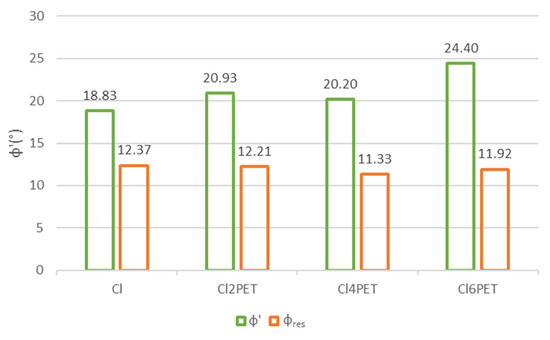
Figure 6.
The variation in internal friction angle for the four admixtures.
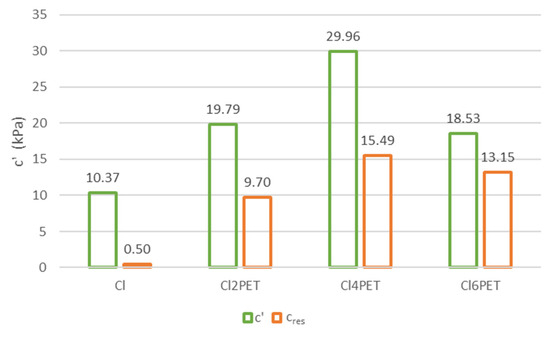
Figure 7.
The variation in cohesion for the four admixtures.
When it comes to Cl6PET, the cohesion value decreased from a value of 29.96 kPa for Cl4PET to a value of 18.53 kPa (Table 5). This decrease may be caused by the high percentage of PET present in the sample, which could have caused a possible sliding of clay particles on the shredded PET. This issue can be investigated in further research through a microscopic analysis of the contacts between clay particles and PET.
Analysing the residual shear parameters, the best result was registered for the cohesion value of the Cl4PET admixture, which was 15.49 kPa. The cohesion value also increased for the Cl2PET and Cl6PET admixtures, but it was lower than the value for the Cl4PET admixture. For the internal friction angle, the values for the three Cl + PET admixtures were slightly lower than the value for the unimproved clay.
The shear strength parameters ϕ and c should not be considered individually but in conjunction with each other, as they together describe the shear strength of the soil. For example, in the case of the Cl6PET admixture, even if the cohesion value decreased compared to Cl4PET admixture, the shear strength increased for the range of vertical stresses applied (σ = 100–200 kPa).
In 2017 Ilieș et al. [9] conducted a comparison between the improvement in a clay, similar with the one used in this study, from a site near Cluj-Napoca, with plastic waste materials and that with cement. Both materials were added in different samples in percentages of 2%, 4%, 6%, and 8%. Direct shear tests were performed on the samples made. In the case of plastic waste materials, the best results were noticed at an addition of 4%. Comparing the results on samples with 4% added cement and those on samples with 4% added plastic waste materials, it can be easily seen that the results in the case of cohesion were 52% lower for plastic waste materials than for cement, similarly for the internal friction angle (a decrease of 63%).
In Table 6, the results of Ilies et al. [9] were compared with the results of this study, in order to analyse all the results and the influence that the addition of PET and cement has on clays from the Cluj-Napoca area. The paper of Ilies et al. [9] was published in the year 2017; therefore, the clay, clay + PET and clay + cement samples were named as follows: unimproved clay—Cl17; clay + 2%, 4%, and 6% PET—Cl2PET17, Cl4PET17, and Cl6PET17; and clay + 2%, 4%, and 6% cement—Cl2CEM17, Cl4CEM17, and Cl6CEM17. In turn, the clay and clay + PET samples obtained in year 2023 in the presented study were named as follows: unimproved clay–Cl23, clay + 2%, 4%, and 6% PET—Cl2PET23, Cl4PET23, and Cl6PET23.

Table 6.
Comparison for shearing parameters of unimproved and improved clay with PET and cement [9].
Comparing the results in Table 6, it can easily be seen that the geotechnical results of clay improved with different percentages of cement are superior to those of clay improved with PET waste. However, it cannot be ignored that even a small addition of PET (2% and 4%) can considerably improve the mechanical characteristics of a clay. The fact that a small addition of plastic waste materials improved the shear parameters of a clay is a good result, especially considering the extremely low costs of obtaining plastic waste materials compared to those of obtaining the additive from cement.
For a slight improvement in the geotechnical characteristics of a clay, the addition of PET waste can be used. This improved soil can be used for constructions with lower loads, for embankment stabilisation or for the base and subbase layer of pavements and road structures. For a greater level of improvement in the geotechnical parameters of a clay, one can switch from adding waste plastic materials to adding hydraulic binders such as cement or lime.
4.2. Oedometric Compression Tests
The variation in specific deformations (ε) for every vertical stress applied (σ′) is shown in Table 7. Analysing the results in Table 7 and the compression–deformation curve (Figure 8), it can be concluded that the most efficient admixture is Cl2PET. The lowest specific deformation was obtained in the case of the clay + 2% PET admixture, with values ranging from 1.040% for a vertical stress of 20 kPa to 13.580% for a vertical stress of 1000 kPa. Throughout the range of applied vertical loads (20–1000 kPa), the specific deformations have a lower value in the case of the Cl2PET mixture than in the case of clay unimproved with waste plastic materials (Cl). As the percentage of PET added to the clay increased to 4% and 6%, the specific deformations also increased compared to the Cl2PET admixture and to the clay in its natural state.

Table 7.
Variation in specific deformations (ε) for every applied vertical stress (σ′).
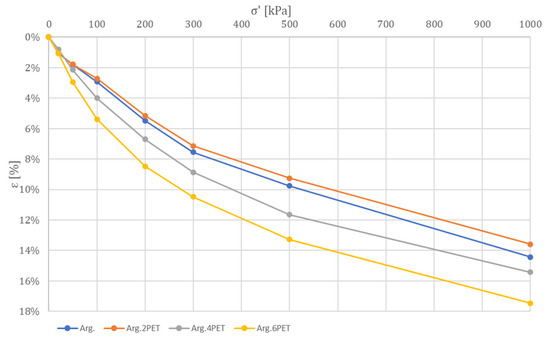
Figure 8.
Compression–deformation curves for the four admixtures.
From the conducted tests, it can be concluded that a small percentage of 2% PET added to a clay can improve its compressibility characteristics by decreasing specific deformations.
The variation in the voids ratio (e) for every applied vertical stress (σ′) is shown in Table 8. Analysing the results in Table 8 and the compression–porosity curve (Figure 9), it can be observed that the admixtures with 2% and 4% PET are the most efficient.

Table 8.
Variation in voids ratio (e) for every applied vertical stress (σ′).
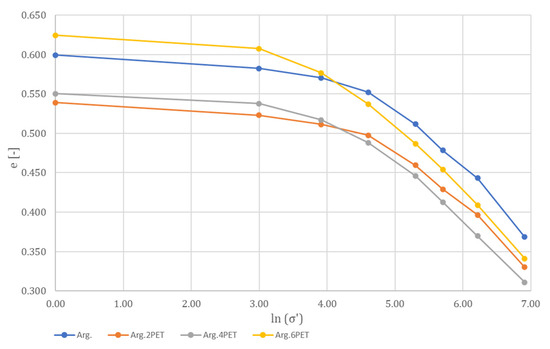
Figure 9.
Compression–void ratio curves for the four admixtures.
The lowest void ratio values were obtained in the case of the clay + 2% PET admixture, with values between 0.539 for a vertical stress of 20 kPa and 0.330 for a vertical stress of 1000 kPa. The lowest voids ratio values throughout the range of applied vertical loads (20–1000 kPa) were recorded for the Cl2PET admixture. Also, for the Cl4PET admixture, the voids ratio values were lower than in the case of natural clay, but higher than in the case of the Cl2PET admixture.
The variation in the oedometer deformation modulus (Eoed) in relation to the effective stress (σ′) is shown in Table 9 and Figure 10. It can be observed that for an addition of 2% PET, the oedometer deformation modulus (Eoed) decreases slightly for the vertical stress range 20–50 kPa. For the rest of the applied vertical loads, the values of the oedometer deformation modulus were higher for the Cl2PET admixture than for the unimproved clay. The best results were obtained for the Cl2PET admixture; for the other two types of admixtures (Cl4PET and Cl6PET), the values of the oedometer deformation modulus were generally lower than those of the initial unimproved clay. Thus, the results indicate an important improvement in the soil stiffness, obtained by a small addition of shredded PET (2%).

Table 9.
Variation in the oedometer deformation modulus (Eoed) for every applied vertical stress (σ′).
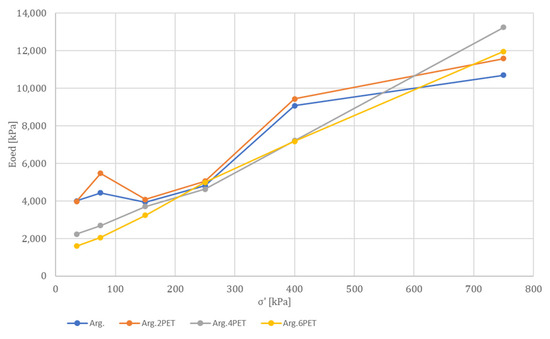
Figure 10.
Variation in the oedometer deformation modulus for the four types of admixtures.
Correlating all the results obtained using the oedometer tests, it can be stated that a small percentage of addition of shredded PET can improve the mechanical characteristics of a clay by decreasing specific deformations and the void ratio variation and increasing the oedometer deformation modulus. In terms of compressibility, the best results were obtained in the case of clay improved with 2% PET waste. For this admixture, the specific deformations and voids ratio variations had the lowest values, and the oedometer deformation modulus values had the highest increase.
Ilies et al. [42] carried out a series of oedometer tests in 2016 on a clay like the one used in this study, improved with different percentages of polyethylene (2%, 4%, 6%, and 8%). It was found that the most suitable percentage of PET for improving the compression parameters of the clay was 4%. The results from that study cannot be compared with those in this paper, because the oedometer tests were different. Vertical axial stresses applied for the tests in 2016 were from 50 kPa to 300 kPa, while in this study the vertical stresses applied were from 20 kPa to 1000 kPa. However, it can be stated that clays from the Cluj-Napoca area can be improved with different percentages of PET, their geotechnical parameters being positively affected by the addition of plastic waste materials.
In another study, this clay improved with 2%, 4% and 6% PET was tested in a climatic cabinet. To simulate the in situ behaviour of the PET-improved clay, four cylindrical samples (Cl, Cl2PET, Cl4PET, Cl6PET), with a diameter and height of 10 cm, were subjected to fifteen freeze–thaw cycles. The temperature varied in the climate cabinet from −10 °C to +40 °C, and the humidity increased up to 90%. It was found that the clay–PET admixtures behaved well in terms of shrinkage cracking. As the percentage of PET in the samples increased, shrinkage cracks decreased. The best results were obtained with a percentage of 6% added PET, the shrinkage cracks being almost inexistent [10].
Analysing the results of the tests carried out on clays from the Cluj-Napoca area, it can be noted that a small percentage of addition of plastic waste materials has positive effects on the mechanical characteristics of a clay. Increases in internal friction angle, cohesion, shear strength, and stiffness and decreases in the deformation and void ratio were observed, for a small addition of polyethylene terephthalate (2% and 4%). This study, corelated with the literature research, has shown that these results are influenced by the amount of PET added to the soil, its shape and its distribution in the studied samples. PET also had a beneficial effect on clay-shrinkage cracks, reducing their number and thickness. These results are encouraging, even if the level of improvement is not as significant as using hydraulic binders. It should be kept in mind that the costs of hydraulic binders are much higher compared to the extremely low costs of plastic waste materials. In addition to the low-cost aspect, it should be considered that recycling and reusing plastic waste materials has a favourable effect on the environment, by reducing pollution and automatically reducing the risks it causes.
5. Conclusions
In this study, the variations in the shear and compression parameters of a clay improved with different percentages of PET were analysed. Based on the experimental results, the conclusions of this study are presented below.
A small addition of PET had a beneficial effect for the shearing characteristics of the soil. The peak shear strength increased with the percentage of PET added to the samples, the most significant variation being registered for an addition of 2% PET. For the Cl2PET admixture, the shear strength showed an increase of 30.51% for σ = 100 kPa, 22.54% for σ = 200 kPa and 19.40% for σ = 300 kPa compared to the shear strength of the unimproved clay (Cl). The highest increase in the internal friction angle was recorded for the Cl6PET admixture, the value increasing from 18.83° for Cl to 24.40° for Cl6PET (an increase of 29.58%). For cohesion, the best result was recorded for the Cl4PET admixture, with a value of 29.96 kPa, an increase of 19.59 kPa compared to the value of Cl (10.37 kPa).
For the residual shear parameters, the best result was registered for the cohesion value of the Cl4PET admixture. The cohesion increased from a value of 0.50 kPa for Cl to a value of 15.49 kPa for Cl4PET. For the internal friction angle, the values for the three clay + PET admixtures were slightly lower than the value for unimproved clay.
A small percentage of 2% PET added to the clay improved its compressibility parameters by decreasing specific deformations. Throughout the entire range of vertical stresses applied (σ′ = 20–1000 kPa), the specific deformations decreased for the Cl2PET admixture, with an average percentage of 4.53%, compared to the deformations for the unimproved clay. For an addition of 2% PET, the void ratio value decreased by an average percentage of 10.25% throughout the entire range of vertical stresses applied (σ′ = 20–1000 kPa), compared with the values of unimproved clay. The clay stiffness was improved for the vertical stresses applied, σ′ = 50–1000 kPa, with an average percentage of 7.39%, at an addition of 2% PET.
The following areas can be explored in future research to complete the study’s results: a microscopic analysis of the contacts between clay particles and PET in the studied samples, as well as an analysis of how PET size and its distribution in the samples affects the clay’s mechanical parameters.
The research in this paper demonstrates that for a slight and moderate increase in the geotechnical parameters of a clay, it can be improved by adding a small percentage of plastic waste materials (2% or 4%). The use of plastic waste materials in soil improvement has a great advantage over the use of hydraulic binders: a very low cost for the procurement of the material with which the improvement can be made.
This method offers solutions to two current global problems: improving soils with weak geotechnical properties and recycling and reusing plastic waste materials in an innovative way, thus contributing to reducing pollution. Although this method of improving soils with plastic waste materials has begun to be increasingly studied by researchers, showing encouraging results, there are few studies that have analysed the behaviour of plastic materials in the subterranean ecosystem. Under varying temperature and humidity conditions, or under the effect of UV radiation, plastic materials can emit certain chemical compounds into the soil. These chemical compounds need to be analysed to find out if they are harmful or not to the ecosystem.
Urian et al. [43] conducted an analysis of the chemical compounds that PET from the clay–PET admixtures releases into the soil, after the application of rapid ageing cycles. It was found that the percentage of PET has an extremely small or no influence on the chemical composition of the clay. Various chemical compounds were identified in clay–PET mixtures, such as lubricants, and aromatic carboxylic acids. These were identified in all samples analysed, indicating their worldwide use. Carboxylic acids have been declared as safe compounds and EU regulations have agreed to their use as additives in polymer production. This study indicates that PET can be used in soil improvement, from a chemical point of view, as it does not represent a threat to the ecosystem.
This paper concludes that the use of PET waste in soil improvement has a beneficial effect on soil strength and compressibility parameters. Special attention is needed to the types of plastic materials used in the improvement process, as they can emit toxic compounds into the subterranean ecosystem. It has been indicated that a chemical analysis of both soil and plastic materials used must be carried out before starting the soil improvement process. Depending on the chemical analysis results, it can be decided whether the improvement solution is environmentally friendly and can be used.
Author Contributions
Conceptualization, N.-M.I. and O.N.; methodology, N.-M.I. and O.N.; software, A.-M.U. and A.-C.N.; validation, A.-M.U. and A.-C.N.; formal analysis, A.-M.U. and A.-C.N.; investigation, A.-M.U. and A.-C.N.; resources, A.-M.U., N.-M.I., O.N. and A.-C.N.; data curation, A.-M.U. and A.-C.N.; writing—original draft preparation, A.-M.U.; writing—review and editing, N.-M.I. and O.N.; visualization, A.-M.U., N.-M.I., O.N. and A.-C.N.; supervision, N.-M.I. and O.N. All authors have read and agreed to the published version of the manuscript.
Funding
This research received no external funding.
Institutional Review Board Statement
Not applicable.
Informed Consent Statement
Not applicable.
Data Availability Statement
The data presented in this study are available on request from the corresponding author. The data are not publicly available due to privacy reasons.
Acknowledgments
The authors gratefully acknowledge the Ministry of Research, Innovation and Digitization for partially supporting this study by the mean of Project 38 PFE in the frame of the program PDI-PFE-CDI 2021.
Conflicts of Interest
The authors declare no conflict of interest.
References
- Bläsing, M.; Amelung, W. Plastics in soil: Analytical methods and possible sources. Sci. Total Environ. 2018, 612, 422–435. [Google Scholar] [CrossRef] [PubMed]
- The New Plastics Economy: Rethinking the Future of Plastics. Available online: https://www.weforum.org/reports/the-new-plastics-economy-rethinking-the-future-of-plastics/ (accessed on 30 June 2023).
- Kumi-Larbi, A.; Yunana, D.; Kamsouloum, P.; Webster, M.; Wilson, D.C.; Cheeseman, C. Recycling waste plastics in developing countries: Use of low-density polyethylene water sachets to form plastic bonded sand blocks. Waste Manag. 2018, 80, 112–118. [Google Scholar] [CrossRef] [PubMed]
- Abu Jadayil, W.; Qureshi, M.R.N.M.; Ajaj, R.; Aqil, E.; Shawahin, G.; Anver, H.; Aljeawi, S. An Empirical Investigation on Plastic Waste Issues and Plastic Disposal Strategies to Protect the Environment: A UAE Perspective. Sustainability 2022, 14, 16719. [Google Scholar] [CrossRef]
- Dutta, S.; Nadaf, M.B.; Mandal, J.N. An Overview on the Use of Waste Plastic Bottles and Fly Ash in Civil Engineering Applications. Procedia Environ. Sci. 2016, 35, 681–691. [Google Scholar] [CrossRef]
- Mallikarjuna, V.; Mani, T.B. Soil Stabilization using plastic waste. Int. J. Res. Eng. Technol. 2016, 5, 391–394. [Google Scholar]
- Dhar, S.; Hussain, M. The strength behaviour of lime-stabilised plastic fibre-reinforced clayey soil. Road Mater. Pavement Des. 2019, 20, 1757–1778. [Google Scholar] [CrossRef]
- Vijayakumar, A.; Naveen Kumar, S.; Abhinayasai Tejareddy, P. Utilization of Waste Materials for the Strengthening of Pavement Subgrade-A Research. Int. J. Innov. Technol. Explor. Eng. 2019, 8, 209–212. [Google Scholar] [CrossRef]
- Ilieş, N.-M.; Cîrcu, A.-P.; Nagy, A.-C.; Ciubotaru, V.-C.; Kisfaludi-Bak, Z. Comparative Study on Soil Stabilization with Polyethylene Waste Materials and Binders. Procedia Eng. 2017, 181, 444–451. [Google Scholar] [CrossRef]
- Trimbitas (Urian), A.-M.; Nemes, O.; Ilies, N.M.; Nagy, A.C. Geotechnical and environmental aspects in soil improvement using plastic waste materials. In Proceedings of the 17th Danube European Conference on Geotechnical Engineering (17DECGE), Bucharest, Romania, 7–9 June 2023; Volume 2, pp. 675–681. [Google Scholar]
- Modak, P.R.; Nangare, P.B.; Nagrale, S.D.; Nalawade, R.D.; Chavhan, V.S. Stabilisation of Black Cotton Soil Using Admixtures. Int. J. Eng. Innov. Technol. 2012, 1, 1–3. [Google Scholar]
- Rica, H.C.; Saussaye, L.; Boutouil, M.; Leleyter, L.; Baraud, F. Stabilization of a silty soil: Effects of disruptive salts. Eng. Geol. 2016, 208, 191–197. [Google Scholar] [CrossRef]
- Vidal, H. The Principle of Reinforced Earth. Highw. Res. Rec. 1969, 1, 1–16. [Google Scholar]
- Hegde, A.; Sitharam, T.G. Use of Bamboo in Soft-Ground Engineering and Its Performance Comparison with Geosynthetics: Experimental Studies. J. Mater. Civ. Eng. 2015, 27, 04014256. [Google Scholar] [CrossRef]
- Mustapha, M. Bamboo as Soil Reinforcement: A Laboratory Trial. Leonardo J. Sci. 2008, 13, 69–77. [Google Scholar]
- Ghosh, S.K.; Bhattacharyya, R.; Mondal, M.M. Potential Applications of Open Weave Jute Geotextile (Soil Saver) in Meeting Geotechnical Difficulties. Procedia Eng. 2017, 200, 200–205. [Google Scholar] [CrossRef]
- Arvind, L.; Bundela, A.K.; Singh, B.; Tiwari, A.; Kumar, A.; Dhemla, P. Identification of Weaker Subgrade Soil in Rajasthan and Increment of CBR by Jute Fiber as Additive. Int. J. Eng. Technol. Manag. Appl. Sci. 2015, 3, 109–113. [Google Scholar]
- Jairaj; Prathap Kumar, M.T. Long-term Performance Studies on Strength Characteristics of Black Cotton Soil Reinforced with Untreated and Treated Coir Fibre. Int. J. Geosynth. Ground Eng. 2018, 4, 25. [Google Scholar] [CrossRef]
- Sivakumar Babu, G.L.; Vasudevan, A.K.; Sayida, M.K. Use of Coir Fibers for Improving the Engineering Properties of Expansive Soils. J. Nat. Fibers 2008, 5, 61–75. [Google Scholar] [CrossRef]
- Ahmad, F.; Bateni, F.; Azmi, M. Performance evaluation of silty sand reinforced with fibres. Geotext. Geomembr. 2010, 28, 93–99. [Google Scholar] [CrossRef]
- Alhassani, A.M.J. Improvement of Sandy Soil Using Materials of Sustainable Consideration. Jordan J. Civ. Eng. 2021, 15, 623–632. [Google Scholar]
- Dang, L.C.; Fatahi, B.; Khabbaz, H. Behaviour of Expansive Soils Stabilized with Hydrated Lime and Bagasse Fibres. Procedia Eng. 2016, 143, 658–665. [Google Scholar] [CrossRef]
- Narani, S.S.; Abbaspour, M.; Mir Mohammad Hosseini, S.M.; Aflaki, E.; Moghadas Nejad, F. Sustainable reuse of Waste Tire Textile Fibers (WTTFs) as reinforcement materials for expansive soils: With a special focus on landfill liners/covers. J. Clean. Prod. 2020, 247, 119151. [Google Scholar] [CrossRef]
- Abbaspour, M.; Aflaki, E.; Moghadas Nejad, F. Reuse of waste tire textile fibers as soil reinforcement. J. Clean. Prod. 2019, 207, 1059–1071. [Google Scholar] [CrossRef]
- Kumar Rai, A.; Singh, G.; Kumar Tiwari, A. Comparative study of soil stabilization with glass powder, plastic and e-waste: A review. Mater. Today: Proc. 2020, 32, 771–776. [Google Scholar] [CrossRef]
- Meddah, A.; Goufi, A.E.; Pantelidis, L. Improving Very High Plastic Clays with the Combined Effect of Sand, Lime, and Polypropylene Fibers. Appl. Sci. 2022, 12, 9924. [Google Scholar] [CrossRef]
- Al-Haddad, S.A.; Al-Ani, F.H.; Fattah, M.Y. Effect of Using Plastic Waste Bottles on Soil Response above Buried Pipes under Static Loads. Appl. Sci. 2022, 12, 12304. [Google Scholar] [CrossRef]
- Mishra, B.; Kumar Gupta, M. Use of randomly oriented polyethylene terephthalate (PET) fiber in combination with fly ash in subgrade of flexible pavement. Constr. Build. Mater. 2018, 190, 95–107. [Google Scholar] [CrossRef]
- Poweth, M.J.; Haneef, F.M.; Krishnan, R.; Rajan, S. Effect of Plastic Granules on the Properties of Soil. Int. J. Eng. Res. Appl. 2014, 4, 160–164. [Google Scholar]
- Singh, J.; Sonthwal, V.K. Improvement of Engineering Properties of soil Using Waste Plastic Bottles Sttips (Polyethylene Tereohthalate). Int. J. Theor. Appl. Sci. 2017, 9, 21–27. [Google Scholar]
- Peddaiah, S.; Burman, A.; Sreedeep, S. Experimental Study on Effect of Waste Plastic Bottle Strips in Soil Improvement. Geotech. Geol. Eng. 2018, 36, 2907–2920. [Google Scholar] [CrossRef]
- Chebet, F.C.; Kalumba, D. Laboratory Investigation on Re-Using Polyethylene (Plastic) Bag Waste Material for Soil Reinforcement In Geotechnical Engineering. Civ. Eng. Urban Plan. 2014, 1, 67–82. [Google Scholar]
- Saha, A.; Maity, J.; Chattopadhyay, B.C. Characteristics of Clayey Soil Mixing with Randomly Distribute Plastic Waste Bags. Int. J. Eng. Adv. Res. Technol. 2017, 3, 42–44. [Google Scholar]
- Soltani-Jigheh, H. Compressibility and Shearing Behavior of Clayey Soil Reinforced by Plastic Waste. Int. J. Civ. Eng. 2016, 14, 479–489. [Google Scholar] [CrossRef]
- Botero, E.; Ossa, A.; Sherwell, G.; Ovando-Shelley, E. Stress–strain behavior of a silty soil reinforced with polyethylene terephthalate (PET). Geotext. Geomembr. 2015, 43, 363–369. [Google Scholar] [CrossRef]
- Zukri, A.; Nazir, R.; Mender, F.N. An experimental study on stabilization of Pekan clay using polyethylene and polypropylene. In AIP Conference Proceedings; AIP Publishing: Long Island, NY, USA, 2017; p. 030002. [Google Scholar]
- NP 126 of 2010; Norm for the Foundation of Constructions on Soils with High Swelling and Shrinkage. Official Gazette of Romania: Bucharest, Romania, 2012.
- STAS 1913/13-83; Foundation Soil. Determination of Compaction Characteristics. Proctor Test. Romanian Institute for Standardization: Bucharest, Romania, 1983.
- STAS 8942/2-82; Foundation Soil. Determination of Earth Strength, by Direct Shearing. Romanian Institute for Standardization: Bucharest, Romania, 1982.
- STAS 8942/1-89; Foundation Soil. Earthes Compressibility Determination by Edometer. Romanian Institute for Standardization: Bucharest, Romania, 1989.
- SR EN ISO 17892; Geotechnical Investigation and Testing. Standardization Association of Romania: Bucharest, Romania, 2015.
- Ilies, N.M.; Farcas, V.; Muresan, O.; Chiorean, V.; Nagy, A.C. Improving clayey soils with polyethylene waste. In Proceedings of the the 13th National Conference on Geotechnics and Foundations, Cluj-Napoca, Romania, 7–10 September 2016. [Google Scholar]
- Urian, A.-M.; Gál, E.; Bizo, L.-A.; Nemes, O.; Ilies, N.M.; Nagy, A.C. Utilizing Plastic Waste Materials in Geotechnical Engineering: A Sustainable Solution for Environmental Challenges. Stud. Univ. Babes-Bolyai Chem. 2023, 68, 115–127. [Google Scholar] [CrossRef]
Disclaimer/Publisher’s Note: The statements, opinions and data contained in all publications are solely those of the individual author(s) and contributor(s) and not of MDPI and/or the editor(s). MDPI and/or the editor(s) disclaim responsibility for any injury to people or property resulting from any ideas, methods, instructions or products referred to in the content. |
© 2023 by the authors. Licensee MDPI, Basel, Switzerland. This article is an open access article distributed under the terms and conditions of the Creative Commons Attribution (CC BY) license (https://creativecommons.org/licenses/by/4.0/).